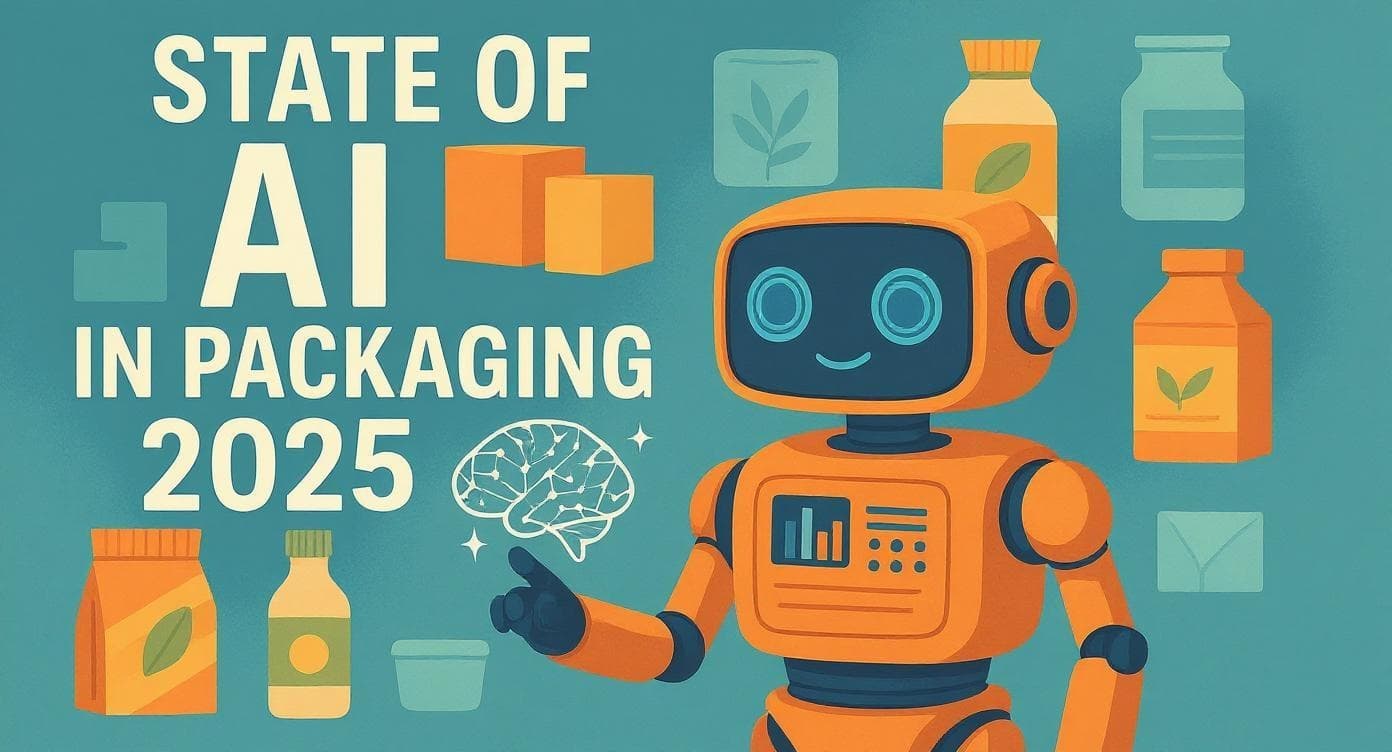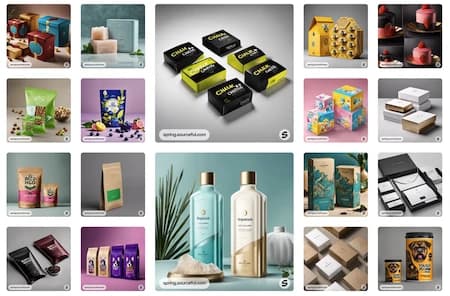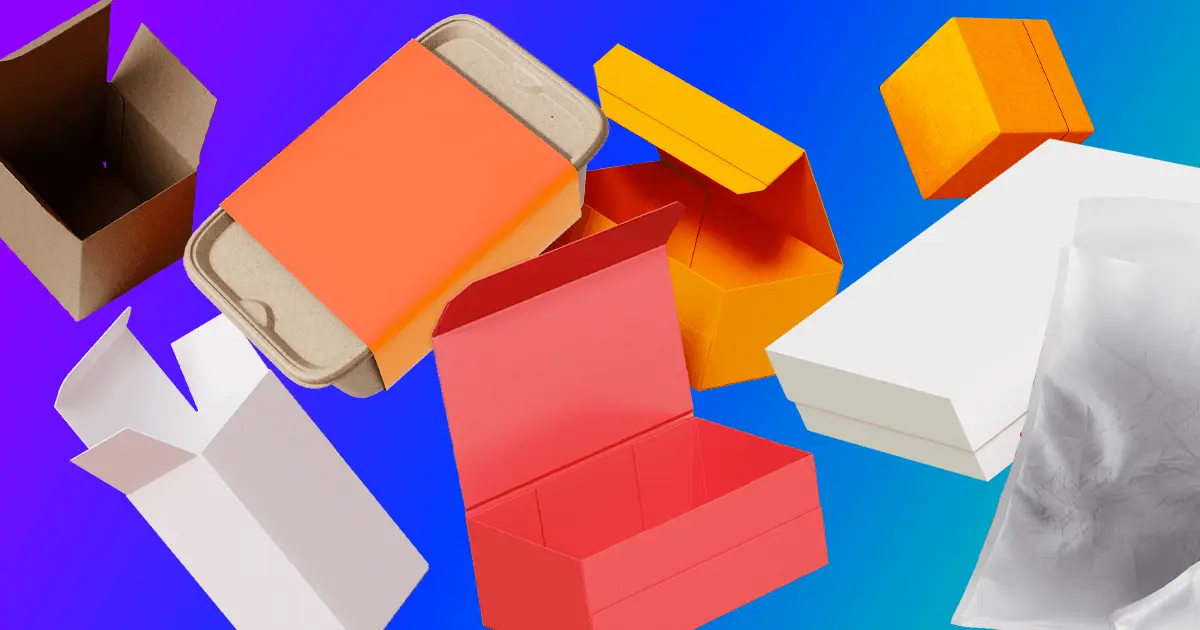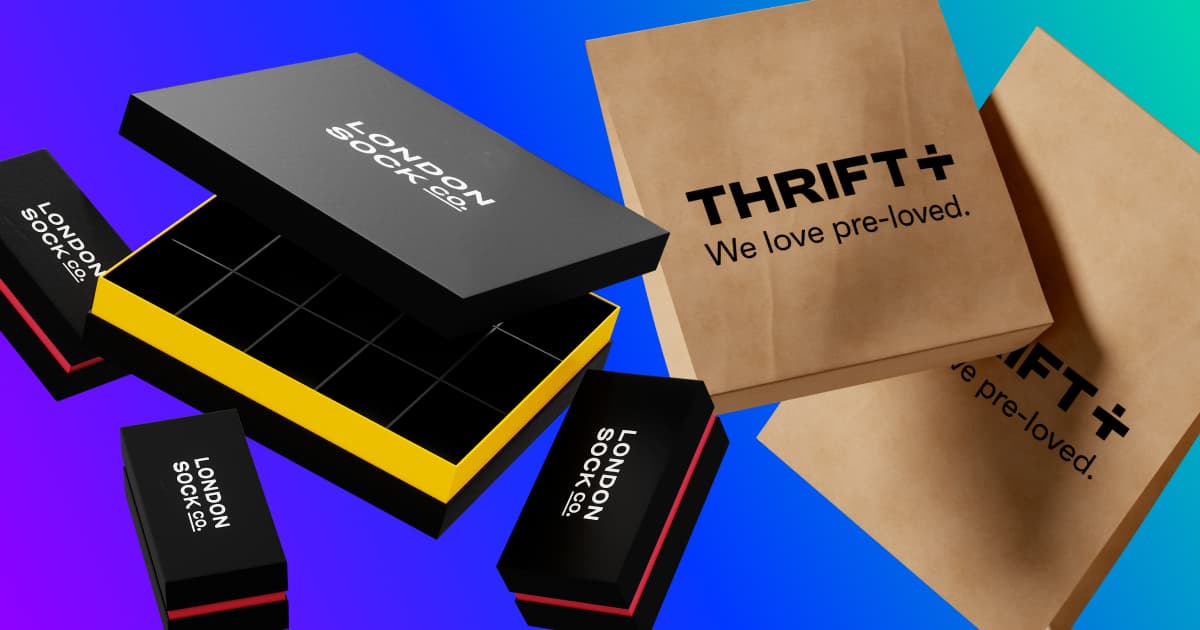Blog Post10 best sustainable packaging materials for eco-friendly companies
- Sustainability
- Materials
- Innovation
Rachel KevernJanuary 17, 2023 - 7 min read

E-commerce sales have doubled in the last five years and are predicted to double again by 2026. This means an increase in packaging. But with the average European citizen creating 5 tonnes of waste every year, forward-thinking brands are looking for more sustainable packaging solutions.
The good news is that, from using right-sized packaging to swapping plastic for paper, there are plenty of options for eco-friendly companies that can make the sustainable switchover easier.
Before we dive in though, let's answer an important question: what is sustainable packaging?
What is sustainable packaging?
Sustainable packaging is packaging that’s made to have the smallest impact on the environment. 100% recyclable packaging is one example. Eliminating wasted space is another, which reduces emissions across materials, production and transport. Put another way, there’s more than one way to make your packaging sustainable. It's important to remember though that sustainable packaging is a relative term. Everything has an impact, and the most sustainable packaging is no packaging.
It’s also important to remember that not all packaging that sounds sustainable is more sustainable. Our recent study, for example, showed that compostable packaging (a type of biodegradable packaging) has up to 2x the impact on climate change than even a virgin plastic bag.
What are sustainable packaging materials?
As the term suggests, sustainable packaging materials are simply the materials that make sustainable packaging. Most of them are recyclable, like corrugated cardboard, as this gives them another life, reducing the need for virgin materials. Others aren’t easily recycled, like mycelium, but are still better alternatives to the status quo.
10 more eco-friendly packaging materials
- Corrugated cardboard
- Cartonboard
- Kraft paper
- Glassine paper
- Recycled paper and card
- Shredded paper
- Starch adhesive
- Recycled plastic bags
- Sugarcane pulp
- Mycelium
1. Corrugated cardboard
Corrugated cardboard is a renewable material that can be sourced from responsibly managed forests. It’s made using cellulose fibres from wood, which are mixed with water into a pulp and then pressed into shape to dry. Corrugated cardboard boxes have long been a popular packaging choice thanks to their strength and customizability. In fact, a third of our products are made using corrugated cardboard, from shipping boxes to our custom inserts.
A variety of fluting thicknesses means you can choose the right level of protection for your product’s needs. This makes your packaging more sustainable in two ways. First, you can avoid using excess materials in your packaging. And secondly, you can reduce the risk of damage during transit, which means fewer returns and fewer transport emissions.
What’s more, when your corrugated cardboard packaging reaches the end of its life, it can be collected at the kerbside and recycled into new cardboard products. This means less waste going to landfill and fewer materials needed to create new products.
.png)
Pros of corrugated cardboard
- Reusable
- Lightweight
- Cost-effective
- Large surface for branding
- Kerbside recyclable
Cons of corrugated cardboard
- Not waterproof
- Unsuitable for very heavy items
- Can degrade with incorrect storage
Common uses: mailer boxes, shipping boxes, crash lock boxes, book wrap mailers, box dividers, custom inserts
2. Cartonboard
Cartonboard, also known as cardboard, is another cellulose-based, renewable material. It is made from either virgin wood pulp or recycled paper and card. It can be cut and shaped in countless ways and is ideal for custom printing.
Cartonboard is good for protecting products from light, moisture and other outside elements. It is a more sustainable alternative to plastic, which fills up landfills, takes at least 400 years to break down and releases harmful greenhouse gases. Cartonboard can also be a more sustainable alternative to glass, styrofoam and aluminium.
We use cartonboard for bespoke cards, which are an attractive way to drive brand awareness and share campaigns with customers.
.png)
Pros of cartonboard
- Versatile
- Low cost
- Recyclable
- Lightweight
- Good for branding
Cons of cartonboard
- Not waterproof
- Not suitable for heavier, larger products
Common uses: cards, food packaging, medication boxes, packaging sleeves
3. Kraft paper
Kraft paper is a renewable material that uses wood pulp from virgin timber. It can also be sourced from FSC-managed forests which aim to guarantee specific sustainability criteria. Kraft paper is a more sustainable alternative to plastic packaging as it’s made from natural resources and doesn't release toxic chemicals during decomposition.
Kraft paper can be found in a variety of Sourceful products, from gummed tape to paper mailer bags. It can be used in place of plastic mailer bags and can even offer in-built protection, like our honeycomb mailer bag.
What’s more, its natural colouring gives it an eco-friendly appearance which can act as a signal of sustainability to your customers.
.png)
Pros of kraft paper
- Cheap
- Renewable
- Lightweight
- Good for branding
- Protects and invests in responsible forestry
Cons of kraft paper
- Less sustainable when bleached
Common uses: mailer boxes, shipping boxes, book mailers, box dividers, crash lock boxes, custom inserts, gummed tape, paper mailer bags, honeycomb mailer bags
4. Glassine paper
Glassine paper is a type of translucent, greaseproof paper made from wood pulp. It has a low permeability, so it offers good protection against air, water and environmental conditions. It’s a good choice for sensitive products that can spoil easily, such as food, cosmetics and books.
Glassine paper can be sourced from sustainably managed forests and recycled after use. Our glassine bags are a more sustainable alternative to single-use plastic mailer bags and switching to these can help you reduce your packaging’s environmental impact.
.png)
Pros of glassine
- Recyclable
- Renewable
- Lightweight
- Translucent
- Moisture and grease resistant
Cons of glassine
- Fragile
- Limited uses
- Not ideal for branding
Common uses: glassine paper bags, wax paper, envelopes
5. Recycled paper and card
In the UK, 80% of paper and card is made using recycled content. They are both widely kerbside recyclable and, after collection, are taken to a paper mill to be processed into large rolls of paper or card. Eventually, they are sent to a manufacturer to create new products, such as writing paper and cardboard boxes. This process can reduce CO2 emissions by 20% compared to incineration. It also diverts waste from landfill, reducing harmful greenhouse gas emissions.
The Forest Stewardship Council’s (FSC) 100% recycled label is one way to know that your packaging has been made from recycled materials. You can find this on products such as book wrap mailers.
.png)
Pros of recycled paper and card
- Renewable
- Recyclable
- Repurposes waste
- Uses 50% less water than virgin paper
- Reduces commercial use of virgin forests
Cons of recycled paper and card
- Degrades when wet
- Production is water intensive
- Doesn’t omit the need for virgin materials
Common uses: book wrap mailer, office paper, toilet paper, greetings cards, newspapers and magazines, paper bags
6. Shredded paper
Shredded paper is paper that’s been cut or torn into small pieces. It can be made from recycled paper products, such as newspapers and cardboard, or virgin fibres.
Shredded paper is used as a void fill to protect items from moving around during transit. As e-commerce items are handled twenty times more than items destined for a retail store, they’re at greater risk of damage. This can affect brand reputation, so protecting your products is important. Shredded paper is a more sustainable alternative to traditional, non-renewable void fillers, such as bubble wrap, styrofoam packing peanuts and plastic air pillows.
Before choosing shredded paper, you should check just how much air you’re shipping. Using the right-sized packaging can reduce gaps in your packaging and reduce your need for void fillers.
Pros of shredded paper
- Non-toxic
- Recyclable
- Can be dyed
- Made from renewable materials
Cons of shredded paper
- Requires large quantities to be effective
- Must be contained in a paper bag to be recycled
Common uses: void filling
7. Starch adhesive
Starch is a renewable material derived from plants such as corn, potato and wheat. It’s mixed with water to create an adhesive paste that can be used to bond paper products, such as corrugated cardboard boxes. As it’s a natural product, it doesn’t contain harmful toxins when it degrades, and it doesn’t affect recyclability.
Our gummed tape uses starch adhesive and FSC-approved kraft paper to create a customizable and more sustainable packaging tape. This can reduce your carbon footprint by up to 50% compared to traditional plastic-based packaging tapes.
Pros of starch adhesive
- Low cost
- Recyclable
- Renewable
- Heat resistant
- Widely available
Cons of starch adhesive
- Poor water resistance
- Can develop mould if stored incorrectly
Common uses: gummed tape, shipping boxes, mailer boxes
8. Recycled plastic bags
Recycled plastic bags are made of plastic waste, such as bags, bottles, packaging materials and common household items. This plastic is melted down into pellets, which can then be used to create new products. Using recycled plastic makes use of plastic that’s already in circulation and prevents it from contaminating landfills and waterways.
Our recycled mailer bags are a more sustainable alternative to traditional poly mailer bags, which are made from virgin plastic. This gives them a lower carbon footprint than poly mailer bags and exempts your business from the Plastic Packaging Tax.
%20(1).png)
Pros of recycled mailer bags
- Recyclable
- Good for branding
- Custom sizing available
- Reduces dependence on virgin materials
- Can save up to 30% CO2 emission compared to virgin mailer mag
Cons of recycled mailer bags
- Often uses some virgin plastic
- Only recyclable at collection points
Common uses: recycled mailer bags
9. Sugarcane pulp
Sugarcane pulp is made from sugarcane fibres, a byproduct of the sugar industry, which would normally be thrown away or incinerated. Blending the fibres creates a pulp which can then be moulded to fit a variety of products and components, as with our sugarcane pulp inserts. The result is packaging that’s ideal for protecting products during transit and showcasing them during unboxing, replacing the need for traditional plastic inserts.
It’s important to remember that sugarcane pulp products and sugarcane “bioplastics” are not the same. Sugarcane pulp is more similar to paper than it is to plastic. Bioplastics need industrial processing to be recycled and they usually end up in landfill, as most cities don’t have this infrastructure. In landfill, they release harmful greenhouse emissions, including C02 and methane.
.png)
Pros of sugarcane pulp
- Strong and sturdy
- Repurposes waste
- Kerbside recyclable
- Sugarcane captures CO2 as it grows
- Can be customised to fit most products
Cons of sugarcane pulp
- Sugar production is land and water intensive
- Fertilisers and herbicides may still be used to protect crops
Common uses: lightweight food containers, films, sugarcane box inserts
10. Mycelium
Mycelium is a renewable, cost-effective replacement for polystyrene packaging. This is the underground root network of mushrooms, which doesn’t need light or water and can grow off a variety of crop waste. It can be grown in less than a week and easily shaped to form snug-fitting, protective moulds.
Retail giants such as Ikea and Dell have both switched to using mycelium as a more sustainable alternative to polystyrene. Estimates claim that polystyrene occupies 30% of landfill space globally, and makes up 90% of marine litter . It also takes 500 years to break down and releases toxic chemicals in the process. Mycelium can offer similar protection to polystyrene without the harmful environmental impact.
Pros of mycelium
- Lightweight
- Customisable
- Water-resistant
- Made from renewable materials
- Cheap to grow and manufacture
Cons of mycelium
- Short lifespan
- Unsuitable for liquids
- Releases greenhouse gases as it decomposes
Common uses: protective inserts
How to choose the most sustainable packaging material for your business
The range and versatility of more eco-friendly packaging options show it’s easier than ever to make the switch to more sustainable packaging. But before deciding on a more sustainable material, it can help to consider your reasons for making the switch, and how you will need your packaging to perform.
Consider your product’s protection needs
What does your product need to be safe so it arrives in the best condition for your customer?
Rather than thinking about void fillers and padding in the first instance, you could consider whether you’re using the right-sized packaging. You might be able to avoid excess material whilst still keeping your product safe simply by ensuring it fits snugly.
Instead of using a mailer box, could you downsize to a mailer bag, saving space and transport costs? Does your mailer bag need to be fully waterproof, or could you opt for one of our splash-proof paper-based bags? The less protection your product requires, the fewer and less-specialised packaging materials you’ll need.
Think about the impression you want your packaging to make
Considering how you want to be perceived by your customers can help you choose the most sustainable and appropriate material for your business.
For example, our unbleached kraft paper is more sustainable than bleached, but its natural appearance has printing implications. Unbleached kraft paper is more suited for block colours, whereas bleached is better for finer details and making colours pop.
Meanwhile, our 98% recycled mailer bags are better for the environment, relatively speaking, but contain white flecks due to the high quantity of recycled content.
Thinking about what you want your packaging to say about your business can help you strike the balance between sustainability and your branding priorities.
Get started with sustainable packaging with Sourceful
The demand for more eco-friendly packaging is increasing. Whilst switching to more sustainable materials may seem daunting at first, knowing what’s available can help you make the right decision for your business.
At Sourceful, we have a range of more sustainable packaging materials that can be customised to meet each and every need.
Contact us to learn more about the products or materials in this article, and let us help you on your way to more eco-friendly packaging.








